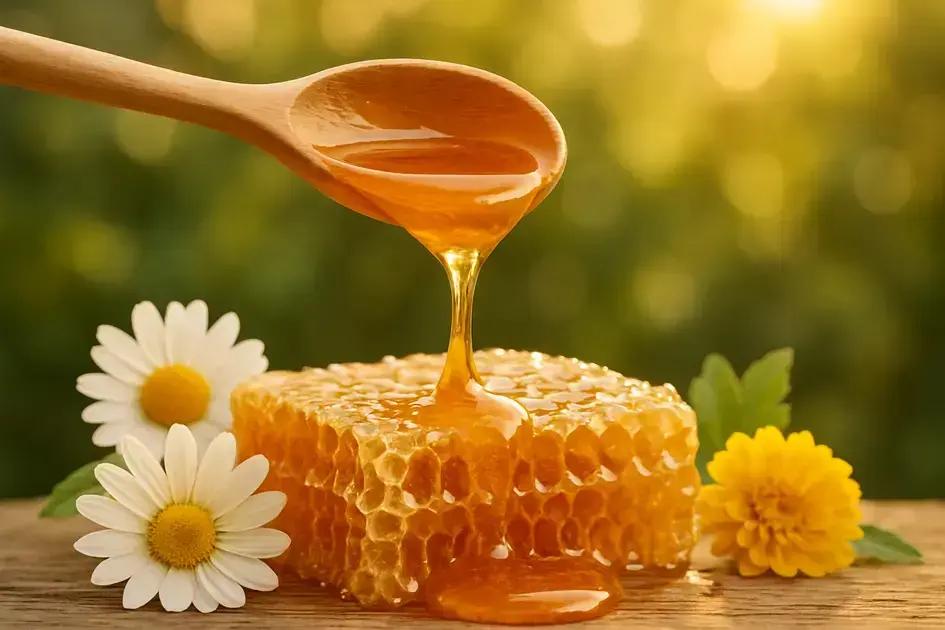=
Raw honey retains natural enzymes, antioxidants, and nutrients due to minimal processing, while processed honey is heated and filtered, losing some health benefits but offering a smoother texture and longer shelf life.
Have you ever wondered about the difference between honey types and which one is better for your health? Raw and processed honey aren’t just about taste; they offer unique qualities that could impact your well-being in surprising ways.
Understanding raw honey
Raw honey is honey that is extracted directly from the honeycomb and is not heated or filtered extensively. This means it retains natural enzymes, vitamins, minerals, and antioxidants that are often removed during processing. Unlike processed honey, raw honey may contain bits of pollen, propolis, and tiny particles of beeswax, which contribute to its unique texture and flavor.
Characteristics of raw honey
Raw honey is usually thicker and cloudier than processed honey due to the presence of natural particles. Its flavor can vary depending on the types of flowers visited by the bees, which makes each batch unique and often richer in taste.
Health benefits of raw honey
Many people prefer raw honey for its potential health benefits. It may help with allergies by exposing the immune system to local pollen. Additionally, the antioxidants found in raw honey can support the immune system and help reduce inflammation.
Because it is less processed, raw honey also retains antibacterial properties that can aid in wound healing and soothe sore throats.
Storage and usage tips
Raw honey should be stored at room temperature in a sealed container to prevent moisture absorption. Over time, raw honey may crystallize, which is a natural process. Simply warming the container gently can restore its liquid form.
What is processed honey?
Processed honey is honey that has been heated and filtered to improve its appearance and extend shelf life. This process removes impurities, such as pollen, air bubbles, and bits of beeswax. However, heating honey at high temperatures can reduce some of its natural enzymes, vitamins, and antioxidants.
Common processing methods
Heating is used to liquefy crystallized honey and make it easier to bottle. It is usually done at temperatures between 104°F and 140°F. Filtration follows heating to remove solid particles, giving processed honey a clearer look.
Effects on nutritional value
While processed honey looks cleaner and is less likely to crystallize quickly, some nutrients and beneficial compounds may be lost during processing. For example, enzymes like diastase and antioxidants that help fight free radicals can be diminished or destroyed by heat.
Why people choose processed honey
Many consumers prefer processed honey because it has a smooth texture, uniform color, and longer shelf life. It is also less likely to crystallize, making it convenient for cooking and baking.
Nutritional differences between raw and processed honey
Raw honey contains higher levels of nutrients compared to processed honey because it is less altered. It retains natural enzymes like diastase and invertase, antioxidants, vitamins such as B-complex and C, and minerals including calcium, iron, and potassium. These components contribute to its potential health benefits.
Enzymes and antioxidants
Raw honey has active enzymes that aid digestion and provide antioxidant effects to help protect cells from damage. Processed honey often loses these enzymes due to heat exposure during pasteurization.
Sugar content and calories
Both raw and processed honey contain mainly natural sugars like fructose and glucose, with similar calorie counts. However, raw honey’s natural composition may help regulate blood sugar better because of its bioactive compounds.
Impact of processing on nutrients
Heating and filtering used in processing can reduce the nutritional value by breaking down heat-sensitive vitamins and antioxidants. While processed honey remains sweet and energy-rich, it offers fewer benefits beyond basic nutrition.
Health benefits of raw honey

Raw honey offers several health benefits thanks to its natural composition. It contains antioxidants, enzymes, and trace minerals that can support overall wellness. Many people use raw honey to soothe sore throats and reduce coughing due to its natural antibacterial properties.
Boosting the immune system
The antioxidants and antibacterial agents in raw honey may help strengthen the immune system. These compounds work to neutralize harmful free radicals and support the body’s natural defenses.
Wound healing and skin care
Raw honey has been used for centuries as a natural wound healer. Its antimicrobial properties can help prevent infection and promote faster recovery when applied to minor cuts or burns.
Digestive health support
Raw honey contains enzymes that can aid digestion and soothe gastrointestinal discomfort. Some people also believe that consuming local raw honey helps reduce seasonal allergy symptoms by exposing the body to small amounts of pollen.
Potential drawbacks of processed honey
Processed honey can lose much of its natural goodness due to the heating and filtering it undergoes. This process often destroys beneficial enzymes and antioxidants that raw honey contains. As a result, processed honey may offer fewer health benefits.
Loss of nutrients
Heating during processing can break down heat-sensitive vitamins and antioxidants. This reduction lessens honey’s natural ability to fight free radicals and support immune health.
Potential additives and contaminants
Some processed honeys might contain added sugars or syrups to increase volume or sweetness, which can reduce purity. Additionally, there is a risk of trace contaminants if production standards are not properly followed.
Effect on flavor and texture
Processing strips away the pollen and other natural elements, resulting in honey with a uniform but less complex flavor. The smooth texture is preferred by some but may feel less natural compared to raw honey.
Tips for choosing the right honey for you
Choosing the right honey depends on your taste preferences and health goals. If you seek maximum nutrients and natural benefits, raw honey is a great choice. It offers antioxidants, enzymes, and unique flavors that vary by floral source.
Consider the source and purity
Look for honey labeled as raw and unfiltered to ensure it retains its natural properties. Local honey can be beneficial as it may help with allergies and supports nearby beekeepers.
Texture and flavor preferences
If you prefer a smooth, clear honey for cooking or baking, processed honey might suit your needs better. However, raw honey has richer, more complex flavors and a thicker texture due to natural particles.
Check for certifications and quality
Certifications like organic or fair trade can signal quality and ethical sourcing. Avoid honey with added sugars, syrups, or artificial ingredients by checking the label carefully.
Ultimately, your choice should fit how you plan to use honey and your personal taste. Sampling different types can help you find the perfect honey for your lifestyle.
Choosing between raw and processed honey
Both raw and processed honey have their benefits and drawbacks, depending on what you value most. Raw honey offers more natural nutrients and unique flavors, while processed honey provides smooth texture and longer shelf life.
Understanding these differences can help you select the honey that fits your taste and health needs best. Whether you prefer the rich qualities of raw honey or the convenience of processed honey, making an informed choice ensures you enjoy the sweet benefits honey has to offer.


